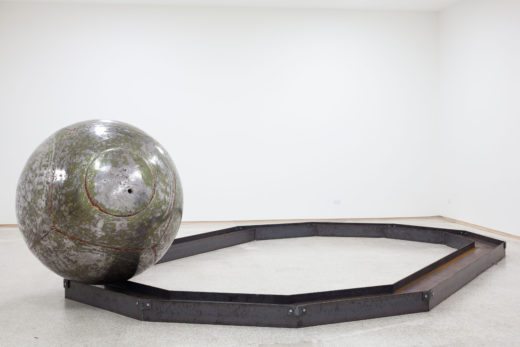Robert Chambers: Iron Oar
Elisa Turner
 Robert Chambers, Trackcendence, 2017. Steel I-beams, BBs, and reclaimed steel buoy. 20 feet, 3 inches x 12 feet, 6 inches; ball: 5 x 5 x 5 feet. Courtesy Emerson Dorsch, Miami
Robert Chambers, Trackcendence, 2017. Steel I-beams, BBs, and reclaimed steel buoy. 20 feet, 3 inches x 12 feet, 6 inches; ball: 5 x 5 x 5 feet. Courtesy Emerson Dorsch, Miami
Emerson Dorsch
May 19–July 8, 2017
The title of Miami sculptor Robert Chambers’s show at Emerson Dorsch, Iron Oar, poses a typically puckish paradox. What sailor takes on board an iron oar? It could sink if not capsize a small boat. Perhaps Chambers has devised an industrial-size pun on iron ore, an example of his interest in challenging the laws of science, particularly––in this case––physics. That fits his signature talent: transforming the industrial sector’s metal castoffs into wry, playfully interactive kinetic art.
Chambers hasn’t had a Miami solo show in over a decade, so Iron Oar is particularly welcome. In June 2016 he was one of several artists based in Miami, Basel, Los Angeles, and Berlin to take part in the annual Ping Pong exhibition at Art Basel in Switzerland. When South Miami-Dade Cultural Arts Center opened in 2011, it was graced by Chambers’s massive Light Field. Commissioned by Miami-Dade County’s Art in Public Places, it illuminates the night sky, transforming the center into a gigantic jewel box. He’s also created outdoor work for Tufts University, Medford; Museum of Science and Industry, Tampa; Shelburne Farms, Vermont; and Laumeier Sculpture Park, St. Louis. Honors include a Nancy Graves Foundation Grant for Visual Artists and Louis Comfort Tiffany Foundation Award. Museums holding his work include Pérez Art Museum Miami and Kemper Museum of Contemporary Art, Kansas City, Missouri.
Chambers likes to think large-scale. Trackcendence, the largest work at Emerson Dorsch (all created in 2017), is still much smaller than many of his past commissions, yet continues his longtime practice of repurposing manufactured parts. A previous work from the 1980s, Holsum Icon, provides a compelling early example of Chambers’s innovative adaptations of mechanical detritus. Chambers created it with gears and a conveyor belt from a long-defunct Miami bakery; it features a crank that when turned set the gears in motion, clicking like a giant toy. Although not part of the current exhibit, intriguing echoes of that early work persist in Iron Ore. This mischievous experimentation with industrial found objects links his work to the kinetic art of Jean Tinguely and Julio Le Parc––the works of all three find absurdist inspiration in humdrum objects. In this show, however, Chambers eschews the additive forms of Tinguely’s famed sculptural machines. And in contrast to Le Parc, Chambers’s interactive kinetic works are not preceded by significant two-dimensional, geometric abstractions.
In Trackcendence, Chambers has again created a massive toy of sorts, but its activation requires physical endurance and mental focus, engendering a meditative experience when the gallery is quiet. What seems a purely playful object evolves into mindful, multisensory performances for viewers. A metal ball over five feet in diameter can be pushed on a decagon-shaped track made of steel I-beams. Despite the ball’s weighty appearance, pushing it is surprisingly easy, even soothing. Once a battleship buoy, the ball bears messy scars of its former life, but Chambers has sanded the surface so it’s smooth to touch. Rolling inside the buoy are oiled BB-gun bullets, creating soft, dripping sounds, recalling falling rain or the sound of rain sticks. This bears a reminder of the centuries-old devices thought to summon rainfall so crops would flourish, now paradoxically paired with a transformed emblem of modern military aggression. Metaphorically, the work responds to our troubled times and earth, possibly illustrating the need for moving forward with sustained focus.
Trackcendence provides a powerful context for other heavy metal, kinetic works here. They propel viewers into intimate, disarming performances.
Elisa Turner is an award-winning art critic and arts journalist who teaches writing at Miami Dade College. She has written for the Miami Herald, ARTnews, Arte al Dia, Art + Auction, Art Circuits, deliciousline.org, and hamptonsarthub.com.









